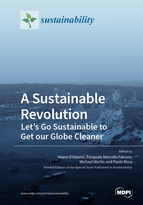A Sustainable Revolution: Let's Go Sustainable to Get our Globe Cleaner
A special issue of Sustainability (ISSN 2071-1050).
Deadline for manuscript submissions: closed (16 March 2020) | Viewed by 116636
Special Issue Editors
Interests: bioeconomy; biomethane; circular economy; e-waste; economic analysis; photovoltaic; renewable energy; sustainability; waste management
Special Issues, Collections and Topics in MDPI journals
Interests: sustainability transitions, energy policy, waste management, circular economy
2. Department of Management, Economics and Industrial Engineering, Politecnico di Milano, Piazza L. Da Vinci 32, 20133 Milano, Italy
Interests: environment; sustainability; environmental impact assessment; sustainable development; environmental analysis; climate change; environmental management; energy; renewable energy; environmental studies; biofuel production; life cycle assessment; biofuels; sustainable consumption and production; life cycle thinking; waste; LCA; bioenergy; biogas; biodiesel; industrial ecology; cleaner production; ethanol; industrial symbiosis; sustainable development goals
Special Issues, Collections and Topics in MDPI journals
Interests: business models; electronic waste; sustainability; recycling; automotive engineering; green marketing; product development; innovation; sustainable development goals
Special Issues, Collections and Topics in MDPI journals
Special Issue Information
Dear Colleagues,
The parties of the United Nations Framework Convention on Climate Change (UNFCCC) reached the Paris Agreement to combat climate change and to intensify the actions needed for a sustainable transition towards a low-carbon future. This transition will require holistic approaches and complex societal changes, requiring solutions and collaboration between, private, public, and academic sectors. Many previous studies have identified potential areas for improving societal environmental impacts by improving large impacting sectors, including transitioning and improving our energy and food supply and transforming our economic system to deliver more environmentally friendly products and services through a more circular and bio-based economy.
This Special Issue aims to encourage studies exploring the transition towards a more sustainable future, encompassing and identifying the development and implications of more sustainable options in collaboration with communities, firms, policy makers, and researchers to achieve this transition.
Theoretical, methodological, and practical studies are welcomed in this Issue. In particular, potential topics include but are not limited to the following:
- The role of renewables in a low-carbon society;
- Policy perspectives on energy, the environment, and related urban trajectories towards sustainability;
- The concept of waste as a resource and the applications of end-of-life strategies in several sectors;
- The contribution of manufacturing technology towards the circular economy;
- The relationship between circular economy models and sustainable advantages;
- Life cycle sustainability assessments; applying environmental, economic, and/or social perspectives, of sustainable transitions;
- The social dimension of sustainability transitions;
- The economic feasibility of projects;
- Practices and actions towards an environmentally friendly society;
- Consequential assessments of sustainable consumption and production;
- The role of subsidies in contrast climate change.
Dr. Idiano D’Adamo
Dr. Pasquale Marcello Falcone
Dr. Michael Martin
Dr. Paolo Rosa
Guest Editors
Manuscript Submission Information
Manuscripts should be submitted online at www.mdpi.com by registering and logging in to this website. Once you are registered, click here to go to the submission form. Manuscripts can be submitted until the deadline. All submissions that pass pre-check are peer-reviewed. Accepted papers will be published continuously in the journal (as soon as accepted) and will be listed together on the special issue website. Research articles, review articles as well as short communications are invited. For planned papers, a title and short abstract (about 100 words) can be sent to the Editorial Office for announcement on this website.
Submitted manuscripts should not have been published previously, nor be under consideration for publication elsewhere (except conference proceedings papers). All manuscripts are thoroughly refereed through a single-blind peer-review process. A guide for authors and other relevant information for submission of manuscripts is available on the Instructions for Authors page. Sustainability is an international peer-reviewed open access semimonthly journal published by MDPI.
Please visit the Instructions for Authors page before submitting a manuscript. The Article Processing Charge (APC) for publication in this open access journal is 2400 CHF (Swiss Francs). Submitted papers should be well formatted and use good English. Authors may use MDPI's English editing service prior to publication or during author revisions.
Keywords
- Economic assessment
- Environmental assessment
- Renewable energy
- Consumption and production
- Food
- Social assessment
- Sustainability transitions
- Sustainable development
- Waste management
- Circular and bio-based economy
- Product end-of-life management
- Industry 4.0
- Life cycle sustainability assessment









